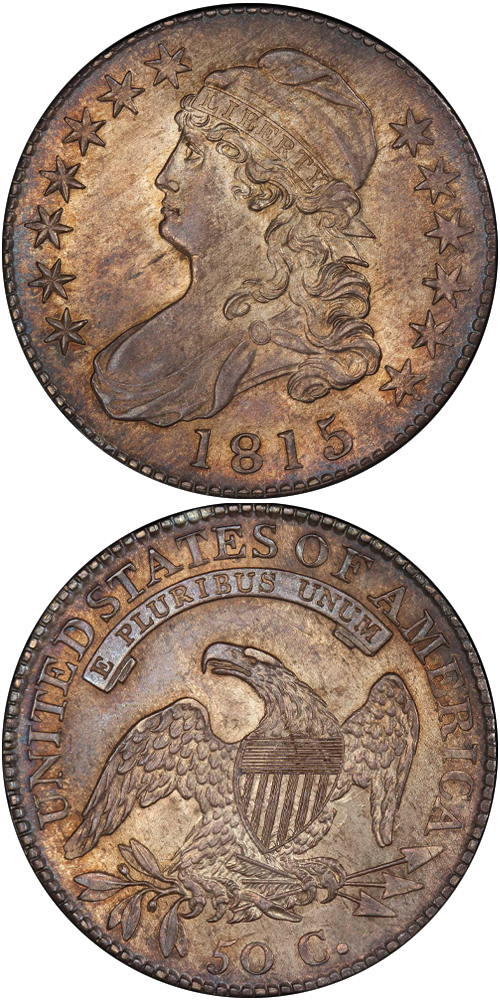1815/2 Capped Bust Half Dollar
Assembling sets of coins by date has been the default methodology of American coin collectors since before the Civil War, when the discontinuation of the large cent in 1857 inspired untold thousands of people to try to find one of every date. Some numismatists had collected issues in date order before that point, but the series that were popular among European and American numismatists in earlier eras hardly lent themselves to such an approach: ancient coins, coins of the world, U.S. colonial issues, medals, and others. A basic truism among date collectors is that the one date that is the hardest to get is recognized as the key to the series. Collectors of large cents discovered before 1860 that 1799 was that key date, with 1804 and 1793 achieving runner-up status. Among half dollars, collectors knew just as early that the 1815 was the key to the Capped Bust half dollar series. Before 1860, 1815 half dollars were commonly sold described as "scarce" or "rare," terms whose usage among Capped Bust half dollars was otherwise saved for Proofs or the occasional overdate variety. Writing in 1859 in his American Numismatical Manual, Montroville W. Dickeson classed the 1815 as "very rare," a category the 1815 shared among half dollars with only 1797 and the non-existent 1804. Even as low grade Capped Bust halves were still encountered in circulation at that time, circulated 1815 half dollars brought a premium to collectors, and high grade specimens achieved strong prices at well-attended numismatic auctions.
Much of the rarity of 1815 half dollars can be attributed to their tiny mintage of 47,150 pieces, a sharp contrast with the mintage figures for the rest of the decade that ranged from just over one million on the low end to 2.2 million at the other extreme. All 1815 half dollars were struck from the same pair of dies, featuring a repurposed 1812 obverse that became an 1815/2 overdate. The entire mintage was turned over to the Mint treasurer on January 10, 1816, the day Mint Director Robert Patterson had the unenviable task of writing to President James Madison to report "this morning, about 2:00, a fire broke out in the mill house, a wooden building belonging to the Mint, which is consumed together with an adjoining building containing the rolling and drawing machines, and also the meting house." The fire made melting and producing precious metal planchets impossible; no silver coins would be struck until 1817, and gold coinage wouldn't recommence until 1818.
Beyond the infinitesimal mintage, another little-appreciated factor may have contributed to the rarity of 1815 half dollars. R.W. Julian's research in the National Archives has revealed that the entire mintage of 1815 half dollars was paid out to a single depositor, cited in Mint records as "Jones, Firth, and Co.," a firm that had deposited "nearly $29,000 in Mexican revolutionary dollars on September 18, 1815," according to Julian. Jones, Firth and Co. was better known as J.C. Jones, T. Firth, & Co., the Philadelphia merchant partnership of Isaac Cooper Jones and Thomas Firth. Jones and Firth were in the import/export trade, "very extensively engaged in the Canton and Calcutta trade," according to the 1846 book Memoirs and Auto-Biography of Some of the Wealthy Citizens of Philadelphia, with a Fair Estimate of Their Estates. They were also involved in the trade to the West Indies, centered at New Orleans, judging from their deposit of Mexican Revolutionary eight reales and a mention of the firm in the incomplete court records of New Orleans in this period. An import/export firm was not acquiring half dollars from the Philadelphia Mint to circulate them; they were turning the crude productions of the Mexican War of Independence into more recognizable and refined American coins that would have been easier to sell in China, India, and the West Indies. There is at least one 1815 half dollar that has turned up with Asian chopmarks, illustrated in John Willem’s book The United States Trade Dollar and offered in the June 1981 Bowers and Ruddy sale, Auction '83, and more recently our Old Colony Collection sale of December 2005. Others may exist; it is a wonder they're not more common.
As a class, 1815 half dollars are highly desirable, narrowly evading the Mint fire of 1816 and a likely fate in a faraway land. In Mint State these survivors are extraordinary rarities. "I doubt if as many as a half dozen 1815 Half-Dollars exist in really Uncirculated condition," B. Max Mehl wrote in the 1941 William Forrester Dunham sale catalog. A small number of gems are known, including the PCGS MS-65+ Kaufman coin (sold as NGC MS-66+ in August 2012 for $182,125) that is now in a famous Iowa collection, the Eliasberg coin, and the piece in the Parsley Collection. The Col. Green-Eric Newman coin, now graded PCGS MS-64+, brought $117,500 in November 2013.
The example to the left was sold by Stack's Bowers Galleries in the D. Brent Pogue Part II Auction, where it realized $111,625.






